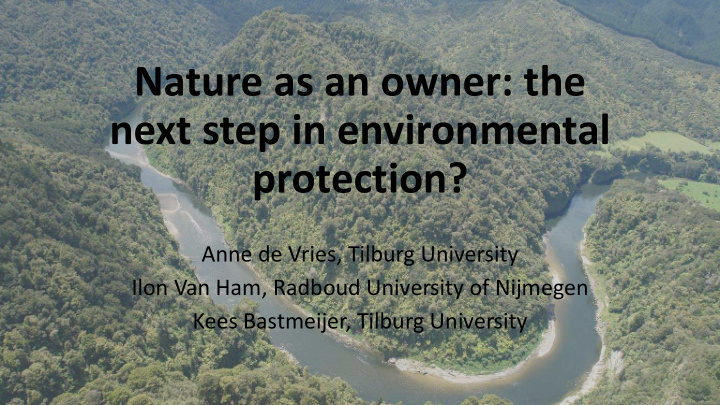



Nature as an owner: the next step in environmental protection? Anne de Vries, Tilburg University Ilon Van Ham, Radboud University of Nijmegen Kees Bastmeijer, Tilburg University
Western (liberal) view on nature “T he earth and all that is therein is given to men for the support and comfort of their being” ( John Locke, 1690)
Nature protection through property rights? • De Vries-Stotijn, Van Ham, Bastmeijer, Protection through property From private to river-held rights, Water International 2019(44), P. 736-751 • The Netherlands: Natuurmonumenten • Society with over 719.000 members • Owning 101,066 hectares (363 areas) • New Zealand: Queens Elisabeth II Trust • Network of private owned properties • More than 182.000 ha (4503 covenants) • Semi-public supervision by trust
• Voluntary • Independent from states • Monitoring and supervision • Long term protection • Lack of specialized knowledge possible • Less suitable for areas owned by • Increasing popularity many different owners • Additional to public • Legal limitations (e.g. no main environmental law positive duties via Dutch • Limits public expenses easement; res nullius) • States become lazy?
Whanganui River: A legal person owning the river
Te Awa Tupua Act 2017 • S 12: “ Te Awa Tupua is “an indivisible and living whole, comprising the Whanganui River from the mountains to the sea, incorporating all its physical and metaphysical elements .” • S 14: “ Te Awa Tupua is a legal person and has all the rights, powers, duties, and liabilities of a legal person .” • The river acts and speaks through a representative body, Te Pou Tupua (S 19(d))
Effects • Transfer of crown-owned parts to Te Awa Tupua (S. 40-41) • Cannot be allianated (S. 43) • River liable as owner (S. 56 & Schedule 5) • Tax (S. 25)
Limitations • The Act does not limit existing private property rights or public use (S. 16 &46) • Private owned parts can be transferred and vested in Te Awa Tupua only with full consent of the private owner (S. 48-49) • Water cannot be owned
Better alternative to no ownership • Strong signal, nature gets • Still human-made, can be “ own ” voice taken away again • Shift in thinking about human- • Private ownership is nature relationship unaffected • Legal standing • Water cannot be owned • Independent from the whims • Practical? of politics • River-owned parts cannot be • Equally expensive for states allianated
The future • Better alternative to no ownership • Legal personality for animals?
Recommend
More recommend